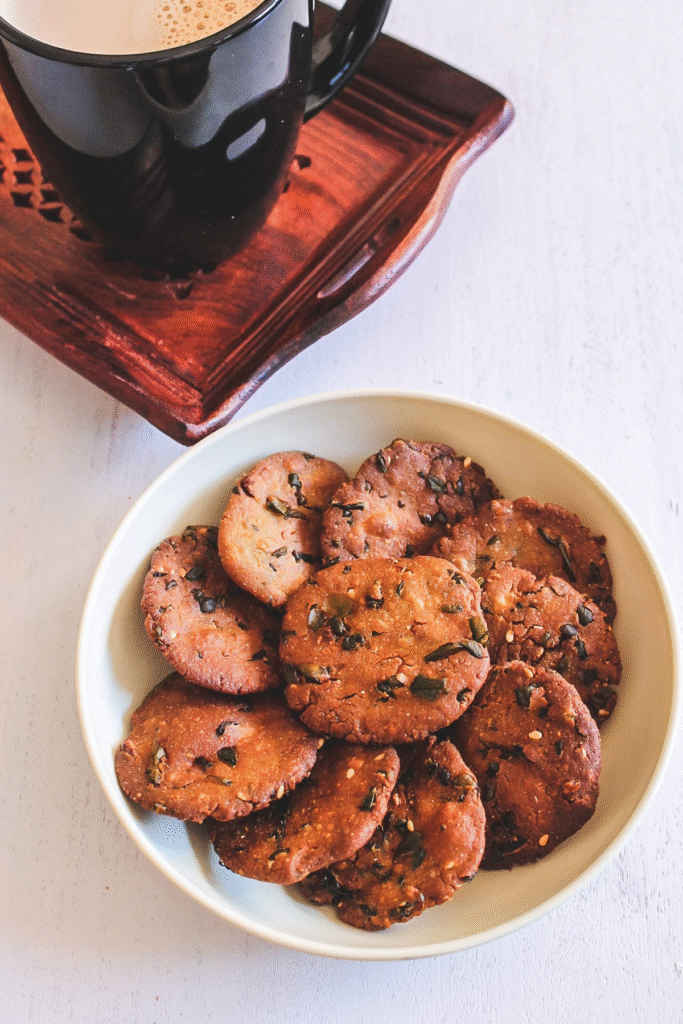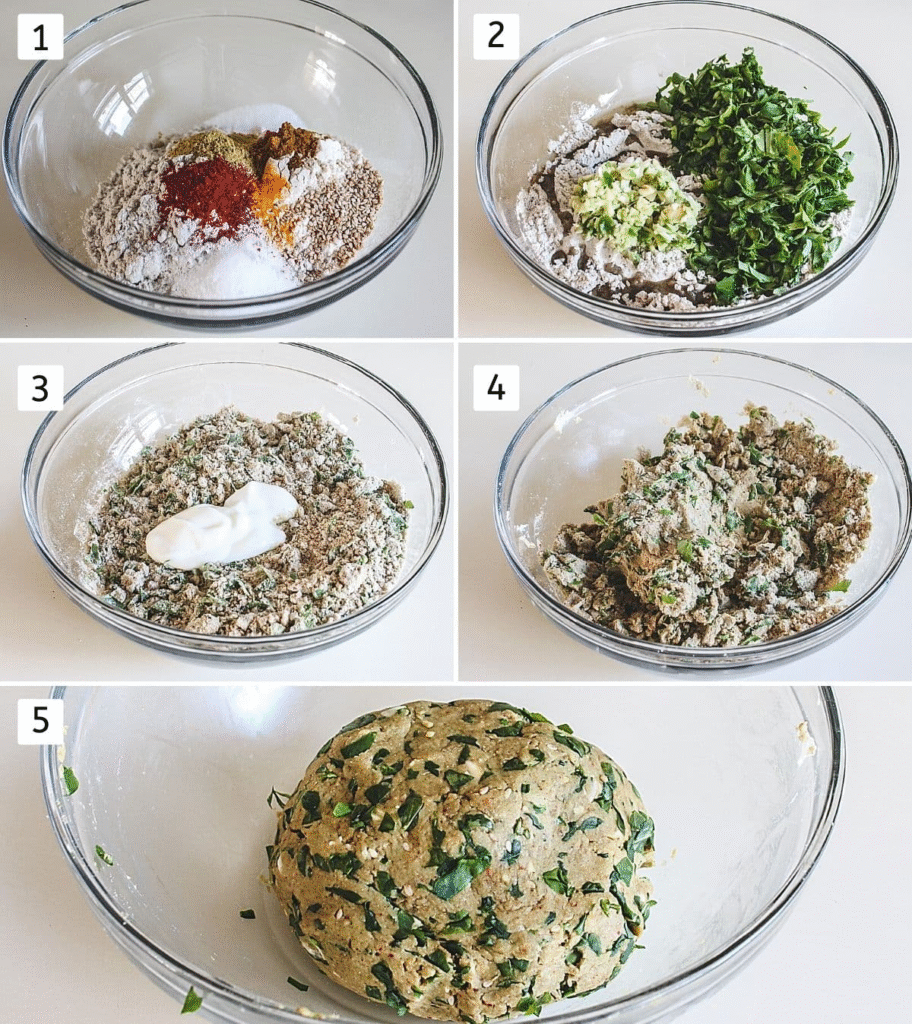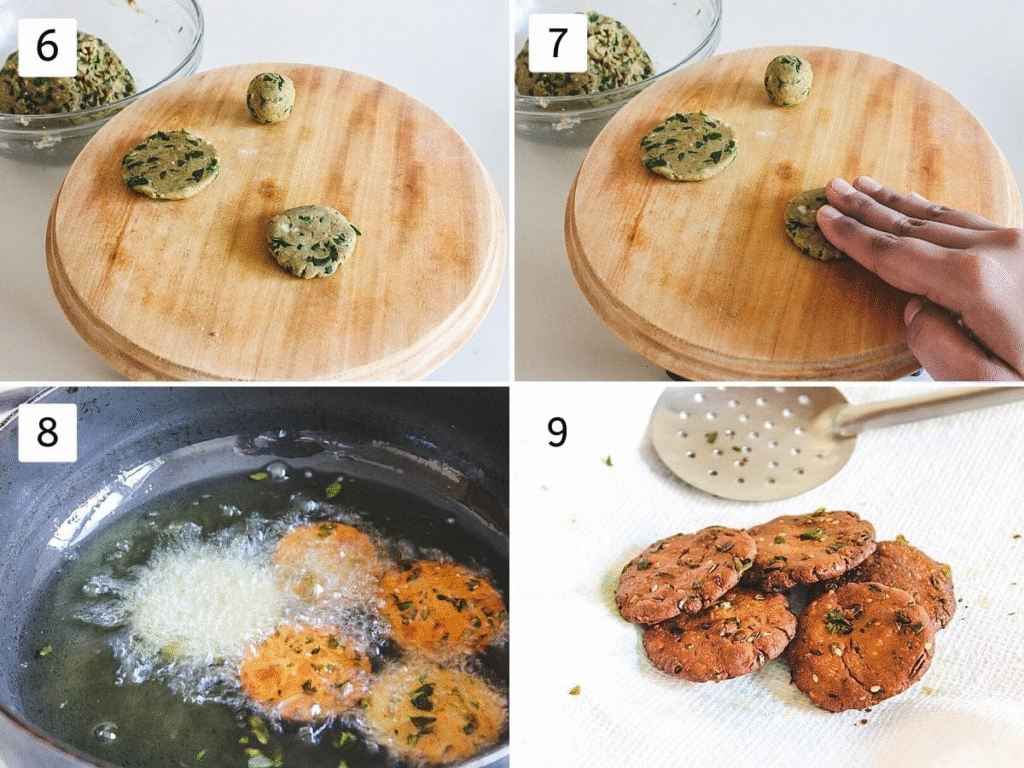Methi Bajri Vada is a time-honored Gujarati snack that blends the earthy richness of bajra (pearl millet flour) with the bold, slightly bitter charm of fresh methi (fenugreek leaves), creating a rustic, flavorful treat that celebrates the essence of traditional Indian cooking. This crispy and flavorful snack is a cherished winter favorite in many Gujarati households, offering both taste and nutrition in every bite.
The dough is prepared by combining bajra flour with finely chopped fresh methi leaves, a touch of spiciness from green chilies and ginger, and a hint of earthiness from carom seeds (ajwain) and sesame seeds. These spices not only enhance the taste but also aid digestion, making the vadas easier on the stomach. A bit of yogurt is added to soften the dough and lend a mild tangy flavor, which pairs perfectly with the natural bitterness of fenugreek.
Once the dough is prepared, it’s molded into small, round patties and either shallow-fried or deep-fried until they turn a beautiful golden brown. Each bite offers a satisfying crunch on the outside, while the inside remains soft, warm, and bursting with the earthy flavors of millet and methi—a perfect harmony of taste and texture. Served hot with green chutney or sweet tamarind chutney, these vadas make for an excellent tea-time treat or a comforting side dish during lunch.
Whether enjoyed during the cold season to warm up the body or simply as a wholesome snack, Methi Bajri Vada captures the rustic flavors of Gujarat in the most heartwarming way.

❤️ You’ll Love This Bajri Vada Recipe
Taste & Texture Profile
These methi bajri vadas offer a delightful burst of flavor with every bite. They are moderately spicy, with the warmth of garlic coming through distinctly. A subtle hint of sweetness and tanginess rounds off the flavor, creating a beautifully balanced taste that satisfies the palate without overwhelming it.
When it comes to texture, these vadas boast a crisp, golden exterior that gives way to a slightly chewy center, making them incredibly enjoyable to munch on. The contrast of crunchy and soft makes them a perfect companion for both casual snacking and festive occasions.
Perfect Pairings & Serving Suggestions
Pair these bajri vadas with a steaming cup of masala chai for a comforting and traditional tea-time treat. They also go exceptionally well with classic Gujarati condiments like mango chunda (a sweet and spicy mango relish) or methia keri (a tangy fenugreek-infused mango pickle). These accompaniments not only enhance the flavor of the vadas but also add a nostalgic, home-style touch to the meal.
Texture Customization Tips
Do you prefer your vadas crunchy or soft? The recipe can easily be adapted to suit your texture preference.
- If you enjoy a crisp and firm bite, follow the standard recipe as it is—this method uses less moisture and the right amount of oil to achieve that signature crunch.
- However, if you lean toward a softer and chewier texture, try reducing the amount of oil slightly and incorporating a bit of water while kneading the dough. This adjustment helps create a more pliable dough, resulting in vadas that are gentler on the bite but still full of flavor.
With their rich taste and customizable texture, these methi bajri vadas are a versatile snack that can be enjoyed in countless ways—whether with your evening tea or as a side on a festive thali.
When Bajri Vada Is Made?
- Perfect Winter Comfort Food: Bajri atta (pearl millet flour) is known for its warming properties, making it an ideal ingredient for cold weather. It naturally helps generate heat in the body, which is especially beneficial during winter. Additionally, winter is the peak season for fresh fenugreek (methi) leaves, adding both flavor and nutrition to the dish.
- Traditional Choice Before Sitla Satam: In households that observe Sitla Satam, cooking is strictly avoided on that day. As part of the tradition, all the meals are thoughtfully prepared a day in advance on the occasion of Randhan Chhath, ensuring that no cooking takes place on the actual day of observance. Methi Bajri Vada is a popular choice for this occasion, as it stays fresh for a couple of days without refrigeration. Alongside vadas, many families also prepare dhebras—both of which are enjoyed cold and remain flavorful even the next day.
🧾 Ingredient Notes
- Pearl Millet Flour (Bajra Atta): For the best flavor and aroma, it’s essential to use freshly ground bajra flour. This not only enhances the taste but also ensures optimal nutritional benefits.
- Winter-Friendly Grain: Bajra is best consumed during the colder months. Though mildly sweet when eaten, it transforms into a warming food after digestion due to its heating properties. It helps maintain body warmth and provides sustained energy, making it ideal for chilly winters.
- Whole Wheat Flour (Gehu Atta): A small portion of wheat flour is incorporated solely to bind the dough since bajra, being gluten-free, tends to break apart easily on its own.
- Fresh Fenugreek Leaves (Methi): I prefer using fresh methi leaves, which are abundant during winter. However, if fresh methi isn’t available, dried kasoori methi or even frozen methi can be used as substitutes.
- Sesame Seeds (Til): These seeds not only bring a subtle crunch and nutty flavor to the vadas but also offer warmth and nourishment during winter—another reason they’re commonly used in cold-season recipes.
- Carom Seeds (Ajwain): Lightly crushing ajwain seeds between your palms before adding them helps release their distinctive aroma and digestive properties more effectively.
- Garlic & Green Chilies: These are crushed together into a paste, either in a mortar and pestle or a wet grinder jar. These vadas lean heavily on garlic for flavor—so feel free to reduce the quantity if you prefer a milder taste.
👩🍳 How To Make Methi Bajri Vada? (Pics)
1. In a large mixing bowl, combine pearl millet flour (bajra atta), whole wheat flour (chapati atta), red chili powder, turmeric, coriander powder, garam masala, a pinch of sugar, salt, sesame seeds, and ajwain (carom seeds). Stir the dry ingredients together until evenly mixed.
2. Add in the crushed green chili and garlic paste along with chopped fresh fenugreek leaves (methi). Pour in some oil and begin mixing the ingredients with your fingertips, rubbing the oil into the flour until it feels like coarse breadcrumbs.
3. Add a few spoonfuls of yogurt and continue mixing. The dough will start to bind but may still feel dry at this stage.
4. Gradually add water, just a teaspoon at a time, and knead into a stiff yet pliable dough. Be careful not to add too much water—just enough to bring everything together smoothly.
5. Pinch off a small portion of the dough (roughly marble-sized), roll it into a ball, then gently flatten it between your palms.

6. Using your fingers, press it into a round disc, smoothing any cracks that appear along the edges. Aim for a thickness of about 1/8 inch and a diameter of 1.5 inches. Set the shaped vadas aside on a plate and keep them covered with a clean kitchen towel to prevent drying.
7. When you’re nearing the end of shaping, start heating oil in a pan over medium heat for frying. Once the oil reaches the right temperature (medium hot), carefully add a few vadas at a time.
8. Fry the vadas, flipping occasionally, until they turn crisp and golden brown on both sides.
9. Use a slotted spoon to remove the fried vadas and transfer them to a plate lined with paper towels to drain excess oil.

💭 Expert Tips
- Do not let the dough rest after kneading. It’s important to start shaping and frying the vadas immediately after the dough is prepared. Resting the dough will cause the methi (fenugreek leaves) to release moisture, which in turn makes the dough too soft and sticky, affecting the texture and shape of the vadas.
- When using frozen methi or dried kasoori methi, be sure to reduce the amount, as both are more concentrated in flavor and volume compared to fresh leaves. These forms are much more concentrated than fresh methi leaves. Since frozen and dried methi have less water content and are densely packed, using the same amount as fresh methi would overpower the flavor and may even alter the dough’s consistency. A rough guideline is to use about one-third the amount if substituting with kasoori methi.
- Seasonal Tip: Add green garlic if available. During the winter months, fresh green garlic is available in many Indian markets. It adds a mild garlicky flavor and aroma that complements the earthy taste of bajra flour and the slight bitterness of methi. Finely chop the green garlic and blend it into the dough along with the rest of the spices for an extra burst of flavor.
- Storage Advice: Once prepared and cooled, methi bajri vadas can be stored in an airtight container at room temperature for 3 to 4 days. Their shelf life and sturdiness make them a perfect snack to pack for road trips, picnics, or even as a travel-friendly meal option. Unlike many other snacks, they do not require refrigeration or reheating, and their texture holds up well even after a couple of days.

